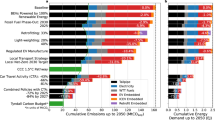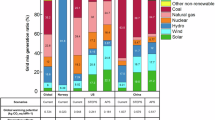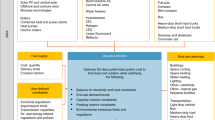Abstract
The electrification of passenger road transport and household heating features prominently in current and planned policy frameworks to achieve greenhouse gas emissions reduction targets. However, since electricity generation involves using fossil fuels, it is not established where and when the replacement of fossil-fuel-based technologies by electric cars and heat pumps can effectively reduce overall emissions. Could electrification policies backfire by promoting their diffusion before electricity is decarbonized? Here we analyse current and future emissions trade-offs in 59 world regions with heterogeneous households, by combining forward-looking integrated assessment model simulations with bottom-up life-cycle assessments. We show that already under current carbon intensities of electricity generation, electric cars and heat pumps are less emission intensive than fossil-fuel-based alternatives in 53 world regions, representing 95% of the global transport and heating demand. Even if future end-use electrification is not matched by rapid power-sector decarbonization, it will probably reduce emissions in almost all world regions.
This is a preview of subscription content, access via your institution
Access options
Access Nature and 54 other Nature Portfolio journals
Get Nature+, our best-value online-access subscription
$29.99 / 30 days
cancel any time
Subscribe to this journal
Receive 12 digital issues and online access to articles
$119.00 per year
only $9.92 per issue
Buy this article
- Purchase on SpringerLink
- Instant access to full article PDF
Prices may be subject to local taxes which are calculated during checkout






Similar content being viewed by others
Data availability
The main data that support the findings of this study are available as supplementary tables. Additional data are available from the corresponding authors upon request.
Code availability
The computer code used to generate the results that are reported in this study are available from the corresponding authors on reasonable request.
References
de Coninck, H. et al. in Special Report on Global Warming of 1.5 °C (eds Masson-Delmotte, V. et al.) 313–443 (IPCC, WMO, 2018).
International Energy Agency Global EV Outlook 2017 (IEA/OECD, 2017).
Clarke, L. E. et al. in Climate Change 2014: Mitigation of Climate Change (eds Edenhofer, O. et al.) 413–510 (IPCC, Cambridge Univ. Press, 2014); https://doi.org/10.1017/CBO9781107415416.012
Kennedy, C. Key threshold for electricity emissions. Nat. Clim. Change 5, 179–181 (2015).
Rogelj, J. et al. in Special Report on Global Warming of 1.5 °C (eds Masson-Delmotte, V. et al.) 93–174 (IPCC, WMO, 2018).
International Energy Agency CO 2 Emissions from Fuel Combustion (OECD/IEA, 2017).
Energy Agenda—Towards a Low-Carbon Energy Supply (Ministry of Economic Affairs of the Netherlands, 2017); https://go.nature.com/385jsT9
Proposal for a Directive of the European Parliament and of the Council on the Promotion of the Use of Energy from Renewable Sources—Analysis of the Final Compromise Text with a View to Agreement (Council of the European Union, 2018); https://go.nature.com/37XxTbO
Cox, B., Mutel, C. L., Bauer, C., Mendoza Beltran, A. & van Vuuren, D. P. Uncertain environmental footprint of current and future battery electric vehicles. Environ. Sci. Technol. 52, 4989–4995 (2018).
Mattinen, M. K., Nissinen, A., Hyysalo, S. & Juntunen, J. K. Energy use and greenhouse gas emissions of air-source heat pump and innovative ground-source air heat pump in a cold climate. J. Ind. Ecol. 19, 61–70 (2014).
McGee, P. Electric cars’ green image blackens beneath the bonnet. Financial Times (8 November 2017); https://go.nature.com/3cf8YUf
Sinn, H.-W. Are electric vehicles really so climate friendly? The Guardian (25 November 2019); https://go.nature.com/396bqup
Mercure, J.-F., Pollitt, H., Bassi, A. M., Viñuales, J. E. & Edwards, N. R. Modelling complex systems of heterogeneous agents to better design sustainability transitions policy. Glob. Environ. Change 37, 102–115 (2016).
Thiel, C., Perujo, A. & Mercier, A. Cost and CO2 aspects of future vehicle options in Europe under new energy policy scenarios. Energy Policy 38, 7142–7151 (2010).
Miotti, M., Supran, G. J., Kim, E. J. & Trancik, J. E. Personal vehicles evaluated against climate change mitigation targets. Environ. Sci. Technol. 50, 10795–10804 (2016).
Onat, N. C., Kucukvar, M. & Tatari, O. Conventional, hybrid, plug-in hybrid or electric vehicles? State-based comparative carbon and energy footprint analysis in the United States. Appl. Energy 150, 36–49 (2015).
Bauer, C., Hofer, J., Althaus, H.-J., Del Duce, A. & Simons, A. The environmental performance of current and future passenger vehicles: life cycle assessment based on a novel scenario analysis framework. Appl. Energy 157, 871–883 (2015).
Jochem, P., Babrowski, S. & Fichtner, W. Assessing CO2 emissions of electric vehicles in Germany in 2030. Transp. Res. A 78, 68–83 (2015).
Wu, Y. et al. Energy consumption and CO2 emission impacts of vehicle electrification in three developed regions of China. Energy Policy 48, 537–550 (2012).
Archsmith, J., Kendall, A. & Rapson, D. From cradle to junkyard: assessing the life cycle greenhouse gas benefits of electric vehicles. Res. Transp. Econ. 52, 72–90 (2015).
Hawkins, T. R., Gausen, O. M. & Strømman, A. H. Environmental impacts of hybrid and electric vehicles—a review. Int. J. Life Cycle Assess. 17, 997–1014 (2012).
Woo, J., Choi, H. & Ahn, J. Well-to-wheel analysis of greenhouse gas emissions for electric vehicles based on electricity generation mix: a global perspective. Transp. Res. D 51, 340–350 (2017).
Saner, D. et al. Is it only CO2 that matters? A life cycle perspective on shallow geothermal systems. Renew. Sustain. Energy Rev. 14, 1798–1813 (2010).
Kikuchi, E., Bristow, D. & Kennedy, C. A. Evaluation of region-specific residential energy systems for GHG reductions: case studies in Canadian cities. Energy Policy 37, 1257–1266 (2009).
Mendoza Beltran, A. et al. When the background matters: using scenarios from integrated assessment models in prospective life cycle assessment. J. Ind. Ecol. 24, 64–79 (2020).
Mercure, J.-F. et al. Environmental impact assessment for climate change policy with the simulation-based integrated assessment model E3ME-FTT-GENIE. Energy Strategy Rev. 20, 195–208 (2018).
Mercure, J.-F. et al. Macroeconomic impact of stranded fossil fuel assets. Nat. Clim. Change 8, 588–593 (2018).
Mercure, J.-F. & Lam, A. The effectiveness of policy on consumer choices for private road passenger transport emissions reductions in six major economies. Environ. Res. Lett. 10, 064008 (2015).
Mercure, J.-F., Lam, A., Billington, S. & Pollitt, H. Integrated assessment modelling as a positive science: private passenger road transport policies to meet a climate target well below 2 °C. Climatic Change 151, 109–129 (2018).
Knobloch, F., Pollitt, H., Chewpreecha, U., Daioglou, V. & Mercure, J.-F. Simulating the deep decarbonisation of residential heating for limiting global warming to 1.5 °C. Energy Effic. 12, 521–550 (2019).
Holden, P. B. et al. Climate–carbon cycle uncertainties and the Paris Agreement. Nat. Clim. Change 8, 609–613 (2018).
Heat Pumps Technology Brief (Energy Technology Systems Analysis Programme (ETSAP) of the International Energy Agency (IEA) and International Renewable Energy Agency (IRENA), 2013).
Schlömer, S. et al. in Climate Change 2014: Mitigation of Climate Change (eds. Edenhofer, O. et al.) 1329–1356 (IPCC, Cambridge Univ. Press, 2014).
Ciez, R. E. & Whitacre, J. F. Examining different recycling processes for lithium-ion batteries. Nat. Sustain. 2, 148–156 (2019).
Dale, M. & Benson, S. M. Energy balance of the global photovoltaic (PV) industry—is the PV industry a net electricity producer? Environ. Sci. Technol. 47, 3482–3489 (2013).
Liu, J. et al. Systems integration for global sustainability. Science 347, 1258832 (2015).
Jordan, A. & Lenschow, A. Environmental policy integration: a state of the art review. Environ. Policy Gov. 20, 147–158 (2010).
Sterner, T. et al. Policy design for the Anthropocene. Nat. Sustain. 2, 14–21 (2019).
Muratori, M. Impact of uncoordinated plug-in electric vehicle charging on residential power demand. Nat. Energy 3, 193–201 (2018).
Richardson, D. B. Electric vehicles and the electric grid: a review of modeling approaches, impacts, and renewable energy integration. Renew. Sustain. Energy Rev. 19, 247–254 (2013).
Fischer, D. & Madani, H. On heat pumps in smart grids: a review. Renew. Sustain. Energy Rev. 70, 342–357 (2017).
Chen, X. et al. Impacts of fleet types and charging modes for electric vehicles on emissions under different penetrations of wind power. Nat. Energy 3, 413–421 (2018).
Tamayao, M. A. M., Michalek, J. J., Hendrickson, C. & Azevedo, I. M. L. Regional variability and uncertainty of electric vehicle life cycle CO2 emissions across the United States. Environ. Sci. Technol. 49, 8844–8855 (2015).
Hertwich, E. G. et al. Integrated life-cycle assessment of electricity-supply scenarios confirms global environmental benefit of low-carbon technologies. Proc. Natl Acad. Sci. USA 112, 6277–6282 (2015).
Gibon, T., Arvesen, A. & Hertwich, E. G. Life cycle assessment demonstrates environmental co-benefits and trade-offs of low-carbon electricity supply options. Renew. Sustain. Energy Rev. 76, 1283–1290 (2017).
Pehl, M. et al. Understanding future emissions from low-carbon power systems by integration of life-cycle assessment and integrated energy modelling. Nat. Energy 2, 939–945 (2017).
Pauliuk, S., Arvesen, A., Stadler, K. & Hertwich, E. G. Industrial ecology in integrated assessment models. Nat. Clim. Change 7, 13–20 (2017).
Gibon, T. et al. A methodology for integrated, multiregional life cycle assessment scenarios under large-scale technological change. Environ. Sci. Technol. 49, 11218–11226 (2015).
Creutzig, F. et al. Bioenergy and climate change mitigation: an assessment. GCB Bioenergy 7, 916–944 (2015).
Cox, B., Mutel, C. L., Bauer, C., Mendoza Beltran, A. & van Vuuren, D. P. Uncertain environmental footprint of current and future battery electric vehicles. Environ. Sci. Technol. 52, 4989–4995 (2018).
Wernet, G. et al. The ecoinvent database version 3 (part I): overview and methodology. Int. J. Life Cycle Assess. 21, 1218–1230 (2016).
Zhang, S. et al. Real-world fuel consumption and CO2 emissions by driving conditions for light-duty passenger vehicles in China. Energy 69, 247–257 (2014).
Duarte, G. O., Gonçalves, G. A. & Farias, T. L. Analysis of fuel consumption and pollutant emissions of regulated and alternative driving cycles based on real-world measurements. Transp. Res. D 44, 43–54 (2016).
Tietge, U., Mock, P., Franco, V. & Zacharof, N. From laboratory to road: modeling the divergence between official and real-world fuel consumption and CO2 emission values in the German passenger car market for the years 2001–2014. Energy Policy 103, 212–222 (2017).
Fontaras, G., Zacharof, N. G. & Ciuffo, B. Fuel consumption and CO2 emissions from passenger cars in Europe—laboratory versus real-world emissions. Prog. Energy Combust. Sci. 60, 97–131 (2017).
Light-Duty Automotive Technology, Carbon Dioxide Emissions, and Fuel Economy Trends—1975 Through 2014 (US Environmental Protection Agency, 2018); https://go.nature.com/2HXxrja
Solid and Gaseous Bioenergy Pathways: Input Values and GHG Emissions (Joint Research Centre of the European Commission, 2014); https://go.nature.com/397sRLk
Well-to-Wheels Analysis of Future Automotive Fuels and Powertrains in the European Context (Joint Research Centre of the European Commission, 2014); https://go.nature.com/394f2xd
Upstream Emissions of Fossil Fuel Feedstocks for Transport Fuels Consumed in the European Union (International Council on Clean Transportation (ICCT), 2014); https://go.nature.com/3cd7Lgp
International Energy Agency. Technology Roadmap—Energy-Efficient Buildings: Heating and Cooling Equipment (IEA/OECD, 2011).
European Commission. Commission Delegated Regulation (EU) No 811/2013 of 18 February 2013 supplementing Directive 2010/30/EU of the European Parliament and of the Council with regard to the energy labelling of space heaters, combination heaters, packages of space heater, temperature control and solar device and packages of combination heater, temperature control and solar device. Off. J. Eur. Union L 239/1, 1–81 (2013).
Space Heating and Cooling—Technology Brief R02 (IEA Energy Technology Systems Analysis Program, 2012).
Hauck, M., Steinmann, Z. J. N., Laurenzi, I. J., Karuppiah, R. & Huijbregts, M. A. J. How to quantify uncertainty and variability in life cycle assessment: the case of greenhouse gas emissions of gas power generation in the US. Environ. Res. Lett. 9, 074005 (2014).
Steinmann, Z. J. N., Hauck, M., Karuppiah, R., Laurenzi, I. J. & Huijbregts, M. A. J. A methodology for separating uncertainty and variability in the life cycle greenhouse gas emissions of coal-fueled power generation in the USA. Int. J. Life Cycle Assess. 19, 1146–1155 (2014).
Knobloch, F., Mercure, J.-F., Pollitt, H., Chewpreecha, U. & Lewney, R. in Technical Study on the Macroeconomics of Energy and Climate Policies (European Commission, DG Energy, 2017); https://go.nature.com/3cdndJl
Mercure, J.-F. Fashion, fads and the popularity of choices: micro-foundations for diffusion consumer theory. Struct. Change Econ. Dyn. 46, 194–207 (2018).
Rogers, E. M. Diffusion of Innovations (Simon and Schuster, 2010).
Wilson, C. Up-scaling, formative phases, and learning in the historical diffusion of energy technologies. Energy Policy 50, 81–94 (2012).
Mercure, J.-F. FTT:Power: a global model of the power sector with induced technological change and natural resource depletion. Energy Policy 48, 799–811 (2012).
Mercure, J.-F. et al. The dynamics of technology diffusion and the impacts of climate policy instruments in the decarbonisation of the global electricity sector. Energy Policy 73, 686–700 (2014).
Knobloch, F., Huijbregts, M. A. J. & Mercure, J.-F. Modelling the effectiveness of climate policies: how important is loss aversion by consumers? Renew. Sustain. Energy Rev. 116, 109419 (2019).
Cambridge Econometrics in Final Report for the European Commission (DG Energy, 2013); https://go.nature.com/2PvVFoK
Mercure, J.-F. et al. in Study on the Macroeconomics of Energy and Climate Policies (European Commission, DG Energy, 2016).
E3ME Manual, Version 6 (Cambridge Econometrics, 2014); https://go.nature.com/2T1FIsO
Acknowledgements
The authors acknowledge funding from the EPSRC (J.-F.M., fellowship no. EP/K007254/1), the Newton Fund (J.-F.M. and P.S., EPSRC grant nos. EP/N002504/1 and ES/N013174/1), the ERC (M.A.J.H. and S.V.H., grant no. 62002139 ERC – CoG SIZE 647224), Horizon 2020 (J.-F.M., F.K. and H.P.; Sim4Nexus project no. 689150) and the European Commission (J.-F.M., H.P., F.K. and U.C.; DG ENERGY contract no. ENER/A4/2015-436/SER/S12.716128). F.K. acknowledges participants of the CIRED summer school in Paris (2018) for valuable discussions.
Author information
Authors and Affiliations
Contributions
F.K. designed the research and wrote the manuscript, with contributions from all authors. S.V.H. and F.K. performed the life-cycle analysis, with contributions from M.A.J.H. F.K., J.-F.M., U.C. and H.P. ran the model simulations. U.C. and H.P. managed E3ME. J.-F.M. and A.L. developed FTT:Transport. F.K. and J.-F.M. developed FTT:Heat. J.-F.M. and P.S. developed FTT:Power.
Corresponding author
Ethics declarations
Competing interests
The authors declare no competing interests.
Additional information
Publisher’s note Springer Nature remains neutral with regard to jurisdictional claims in published maps and institutional affiliations.
Supplementary information
Supplementary Information
Supplementary Figs. 1–6 and Methods 1–4.
Supplementary Tables
Supplementary Tables 1–9.
Rights and permissions
About this article
Cite this article
Knobloch, F., Hanssen, S., Lam, A. et al. Net emission reductions from electric cars and heat pumps in 59 world regions over time. Nat Sustain 3, 437–447 (2020). https://doi.org/10.1038/s41893-020-0488-7
Received:
Accepted:
Published:
Issue Date:
DOI: https://doi.org/10.1038/s41893-020-0488-7
This article is cited by
-
Worldwide greenhouse gas emissions of green hydrogen production and transport
Nature Energy (2024)
-
Sustainable plug-in electric vehicle integration into power systems
Nature Reviews Electrical Engineering (2024)
-
Energy and environmental impacts of air-to-air heat pumps in a mid-latitude city
Nature Communications (2024)
-
Co-benefits of transport demand reductions from compact urban development in Chinese cities
Nature Sustainability (2024)
-
Based on an environmental-friendly society, material modification technique to improve the performance of the lithium-ion battery
Environment, Development and Sustainability (2024)




